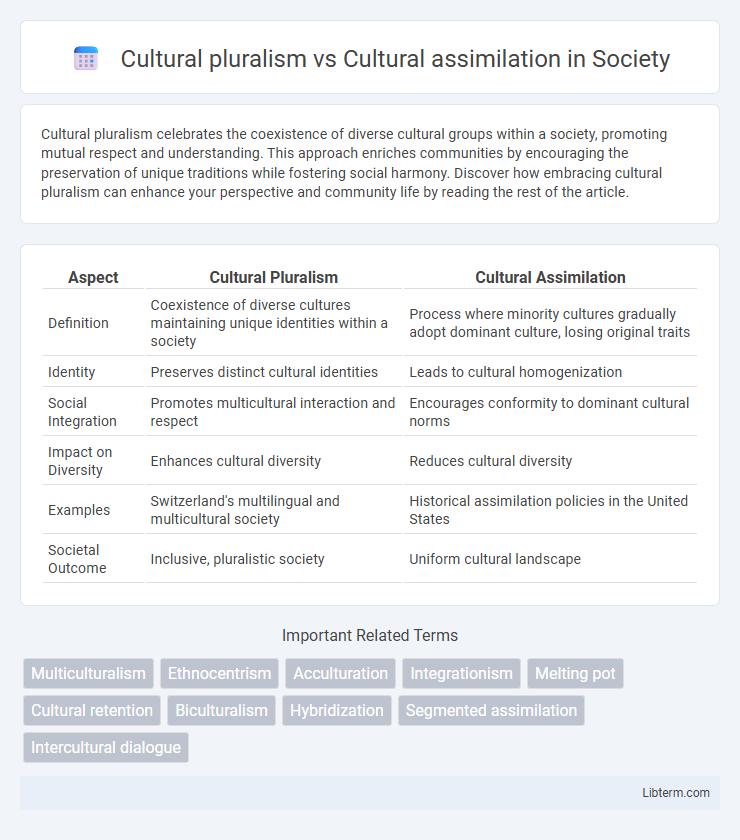Cultural pluralism celebrates the coexistence of diverse cultural groups within a society, promoting mutual respect and understanding. This approach enriches communities by encouraging the preservation of unique traditions while fostering social harmony. Discover how embracing cultural pluralism can enhance your perspective and community life by reading the rest of the article.
Table of Comparison
| Aspect | Cultural Pluralism | Cultural Assimilation |
|---|---|---|
| Definition | Coexistence of diverse cultures maintaining unique identities within a society | Process where minority cultures gradually adopt dominant culture, losing original traits |
| Identity | Preserves distinct cultural identities | Leads to cultural homogenization |
| Social Integration | Promotes multicultural interaction and respect | Encourages conformity to dominant cultural norms |
| Impact on Diversity | Enhances cultural diversity | Reduces cultural diversity |
| Examples | Switzerland's multilingual and multicultural society | Historical assimilation policies in the United States |
| Societal Outcome | Inclusive, pluralistic society | Uniform cultural landscape |
Understanding Cultural Pluralism
Cultural pluralism emphasizes the coexistence of diverse cultural groups within a society, recognizing and valuing their distinct traditions, languages, and beliefs. It supports the preservation of unique cultural identities while promoting mutual respect and interaction among different communities. This approach contrasts with cultural assimilation, which encourages minority groups to adopt the dominant culture, often leading to the loss of original cultural traits.
Defining Cultural Assimilation
Cultural assimilation refers to the process by which individuals or groups adopt the cultural traits, values, and behaviors of a dominant society, often resulting in the loss of their original cultural identity. This process emphasizes uniformity and integration into the prevailing social framework, contrasting with cultural pluralism, which encourages the coexistence of diverse cultural identities within a society. Assimilation is frequently measured through language adoption, social participation, and changes in cultural practices.
Historical Context of Cultural Integration
Cultural pluralism in historical contexts often reflects societies where multiple ethnic groups maintain distinct cultural identities while coexisting within a shared political framework, exemplified by the Austro-Hungarian Empire's diverse populations during the 19th century. Cultural assimilation, conversely, typically involves minority groups gradually adopting the dominant culture's practices and values, such as Native American communities in the United States undergoing forced assimilation policies during the late 19th and early 20th centuries. These differing approaches to cultural integration reveal contrasting government policies and social attitudes toward diversity and uniformity throughout history.
Key Differences Between Pluralism and Assimilation
Cultural pluralism emphasizes the coexistence of diverse cultural groups maintaining distinct identities within a society, while cultural assimilation involves minority groups adopting the dominant culture, often losing unique cultural traits. In pluralism, cultural diversity is valued and preserved, promoting inclusivity and mutual respect, whereas assimilation prioritizes uniformity and integration into the dominant cultural norms. The key differences lie in identity retention--pluralism supports multiple cultural identities, assimilation encourages a single, homogenous identity.
Benefits of Cultural Pluralism
Cultural pluralism fosters a dynamic society where diverse cultural groups maintain their unique identities while contributing to a shared social framework, enhancing creativity and innovation through varied perspectives. It promotes social cohesion by encouraging mutual respect and understanding, reducing discrimination and conflicts that often arise from forced assimilation. Embracing cultural pluralism supports economic growth and global competitiveness by leveraging multicultural skills and networks in an interconnected world.
Challenges of Cultural Assimilation
Cultural assimilation presents significant challenges including the loss of original cultural identity and heritage, leading to increased feelings of alienation and marginalization among minority groups. Language barriers, discrimination, and lack of social support further impede the integration process and contribute to psychological stress. These challenges hinder cohesive multicultural societies and emphasize the importance of policies promoting cultural pluralism that respect diverse cultural backgrounds.
Real-World Examples of Both Approaches
Cultural pluralism thrives in countries like Canada, where multicultural policies encourage the preservation of distinct ethnic identities within a unified society, evident in festivals like Caribana celebrating Caribbean heritage. By contrast, the United States historically leaned toward cultural assimilation, promoting the "melting pot" ideal where immigrants adopt dominant cultural norms, exemplified by early 20th-century policies encouraging English language use and American customs. These approaches impact social integration, with pluralism fostering inclusivity and diverse representation, while assimilation often prioritizes conformity and social cohesion.
Impact on Identity and Social Cohesion
Cultural pluralism preserves diverse identities by encouraging the coexistence of multiple cultural groups within a society, fostering mutual respect and reducing social tensions. In contrast, cultural assimilation often leads to the erosion of minority identities as individuals adopt the dominant culture, which can create feelings of alienation and weaken social cohesion. Societies embracing pluralism typically experience stronger communal bonds and inclusive social networks, while assimilation-driven contexts may struggle with identity conflicts and fragmented communities.
Policy Approaches Toward Cultural Diversity
Policy approaches toward cultural diversity often contrast cultural pluralism and cultural assimilation, emphasizing distinct strategies for managing societal differences. Cultural pluralism policies promote the coexistence and mutual respect of diverse cultural groups by supporting multicultural education, language rights, and anti-discrimination laws, thereby fostering inclusivity without erasing individual identities. In contrast, assimilationist policies encourage minority groups to adopt the dominant culture's norms and values, prioritizing national unity and integration often through standardized language use and educational curricula that emphasize a singular cultural narrative.
The Future of Multicultural Societies
Cultural pluralism promotes the coexistence of diverse cultural identities within a single society, encouraging mutual respect and preservation of unique traditions. Cultural assimilation, on the other hand, involves the absorption of minority cultures into a dominant mainstream, often leading to the loss of distinct cultural traits. The future of multicultural societies depends on balancing these dynamics to foster inclusive environments where diversity strengthens social cohesion and innovation.
Cultural pluralism Infographic

 libterm.com
libterm.com